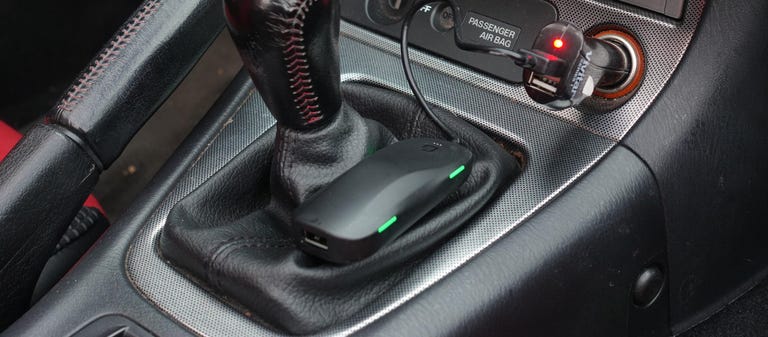 Why You Can Trust CNET
Why You Can Trust CNET This smart tire-pressure monitor brings high tech to low-tech cars
Just because you drive an old car doesn't mean you can't have the fancy safety gadgets.
Not all cars come with the latest, greatest tech, and many of us drive much older, pretech cars. For example, I love my 2004 Mazdaspeed Miata like she's my child, but she is woefully short on electronics: no back up camera, no Apple CarPlay, no adaptive cruise control and no tire-pressure monitoring system.
Given the importance of tire pressure for safety and fuel economy, I gave the Zus Smart Tire Safety Monitor a try. This aftermarket system tracks tire pressures and temperatures using four Bluetooth-enabled valve caps, an app and a receiver. The valve caps send pressure information to the receiver, which then connects to the app.
The system is pretty simple, just four valve caps, a receiver and the Zus app on your phone.
The system took less than 10 minutes to install in the Miata. I just downloaded the app to my phone, twisted the caps onto my tires' valve stems, and plugged the rather large car-shaped receiver into the USB port (although my car is so old I had to get a 12V adapter). To calibrate the receiver I drove at 15 miles an hour for about 50 yards, after which the four lights on the receiver, each representing a single tire, turned green to indicate all was well.
The Zus caps are a bit larger than your standard valve stem cap.
To test the Zus Smart Tire Safety Monitor, I drove from San Francisco to Los Angeles, checking its readings against my own measurement of the tire pressure, and watching how temperature differences affected the pressure readings.
At the start of my drive, the Smart Tire Safety Monitor recorded a tire temperature of 66 to 68 degrees, with each tire holding anywhere from 29.9 to 30.4 pounds of air per square inch. I checked my tire pressure before I installed the Zus caps with a digital tire pressure gauge and found them to be within 0.6 to 2.1 psi of the measurement the Zus was getting. That's a pretty big variance, and I'm not sure if it was my digital gauge or the Zus that was off . However, the numbers evened up after my six-hour drive. The Zus recorded tire temperatures anywhere from 75 degrees to 79 degrees, with a psi of about 33. A quick check with my digital gauge and I found all the pressures to be within 0.6 psi.
Screenshots of the Zus app before and after six hours of driving.
That's useful information, sure, but I've gone without a tire pressure monitor for this long, and I regularly check my tires before a long trip, so why do I need this tech? A big part of the answer is convenience. Why crouch down at each tire before a trip when you can just hop in the car, check the Zus app and go?
The AccurateTemp page can tell you if you have a slow leak.
The Zus can also help keep you safe as underinflation can cause tire separation or a catastrophic blow-out. The system can detect a slow leak, the result of getting a nail stuck in your tire, and there is also the threat of less-than-ideal road conditions, which I found out on my way back to San Francisco.
After getting stuck in stop-and-go traffic on the interstate, I turned off on a secondary road to bypass the mess. A semi-truck had the same idea, and just as I passed it the two-lane country road turned to utter crap. The smooth blacktop gave way to potholes the size of Montana, and here I was doing 80 miles per hour next to a Goliath of a vehicle.
As my little Miata slammed into one pothole after another, I thought, "It's late at night, I've probably got a flat, it's dark and my spare and jack are buried in the trunk."
Then I checked the Zus receiver. All lights glowed green, and the app remained silent in its tacit approval of my choice of road.
It's cool to be able to retrofit my older car with safety tech, but there are a few quirks to the Zus Smart Tire Safety Monitor. The default range of acceptable pressure is between 31 and 35 psi. If you're running larger tires or have any special applications, you'll have to be sure the app and receiver are connected and then go into settings and change the default range. If you're unsure what pressure is correct, there is usually a label with the recommended pressure on your car's door jamb or you can check your manual. If you don't know what size of rubber you're rolling on, you can read the sidewall for information regarding tire size and type. You'll see in the photos that the app recommended I keep the tire pressure at 35 psi, but the ride on my car is more comfortable at around 30 psi.
Aesthetically the receiver looks pretty cool, but it's on a short cord so I couldn't stow it away in the glove box. The app pings you in case of a problem, so it's not necessary to have the receiver in sight at all times.
Having said that, if you want to start outfitting your analog car in this digital world, the Zus Smart Tire Safety Monitor system is a good place to start. It will ship starting August 17 for $120. It's a pretty good price for the amount of tech you're getting, and just might save your life, or at the very least, your tire.
There isn't really a place for the receiver in the tiny cabin of the Miata.


